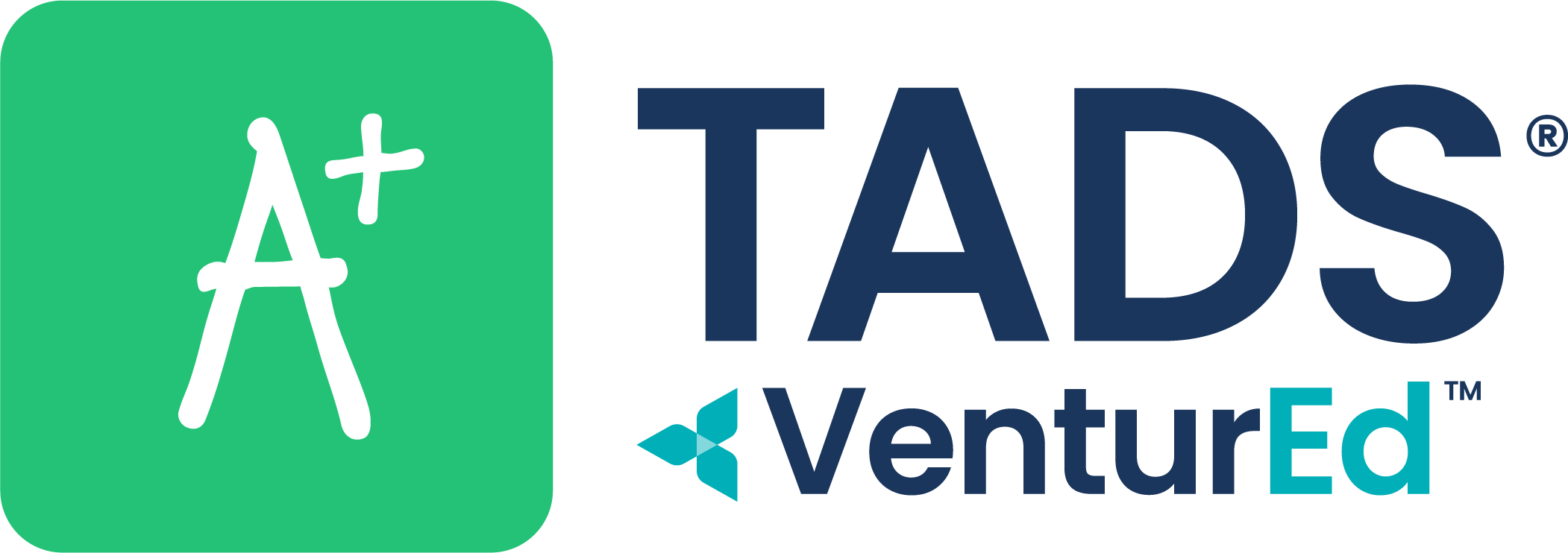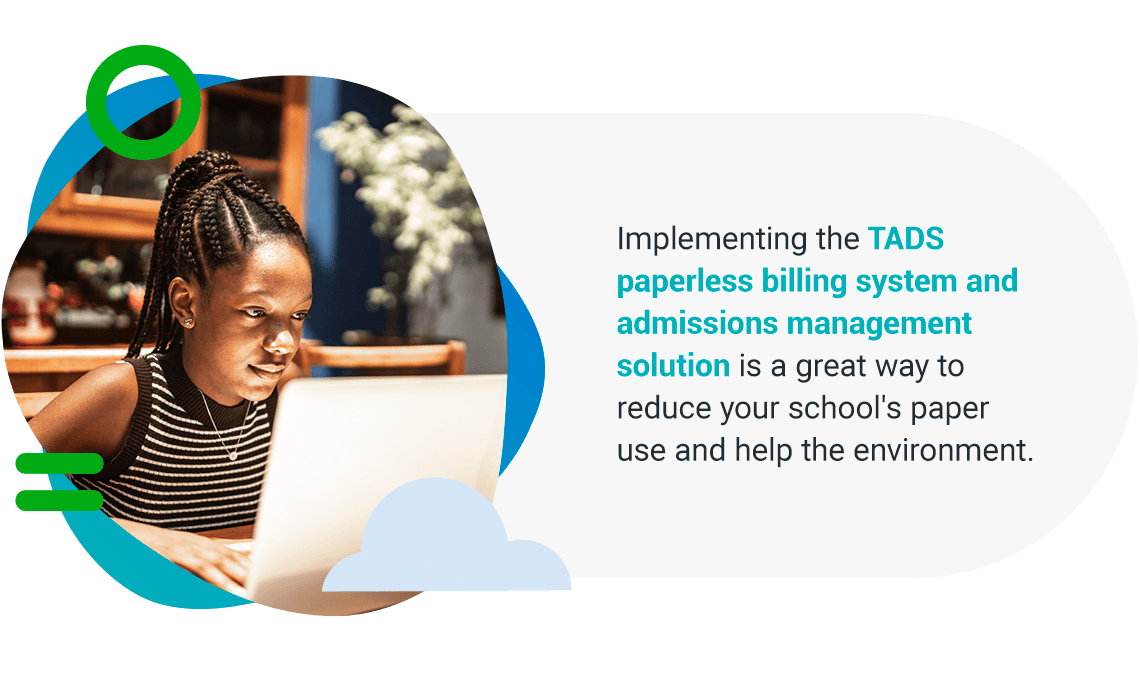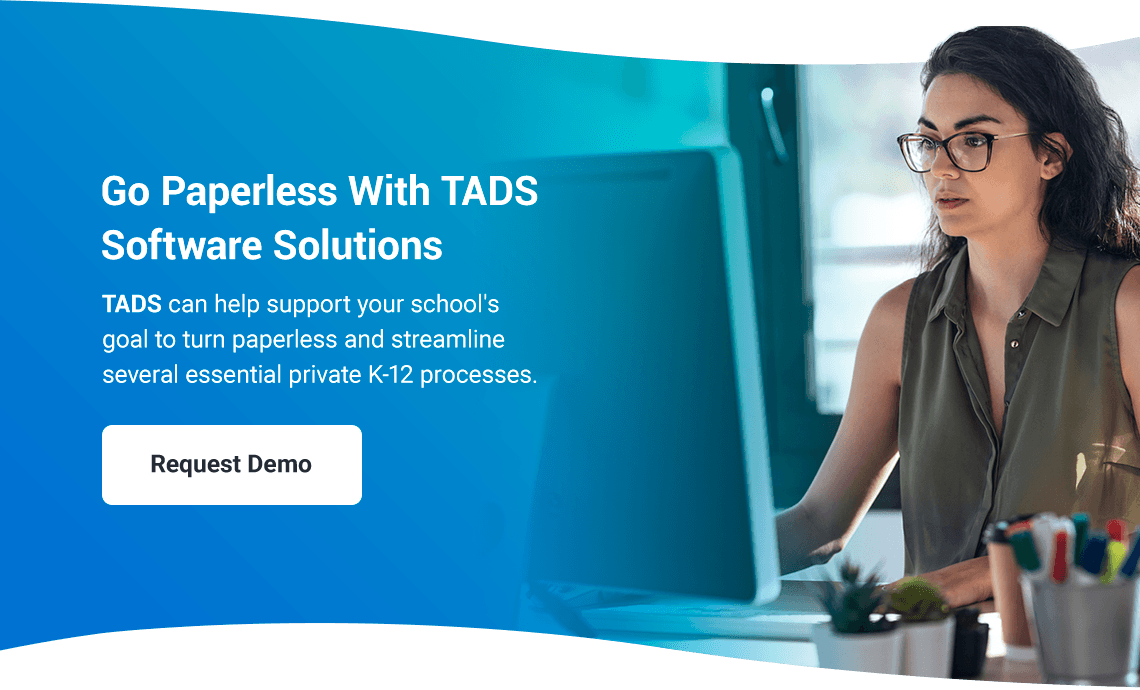
Paper can be a significant source of waste for private K-12 schools. TADS is a paperless solution for schools, enabling the online management of admissions, enrollment, financial aid, tuition payments, and other essential processes. With this approach, you can eliminate paper use at your school and create more efficient and organized operations to support families and faculty.
Learn more about why schools should go paperless and how TADS can help.
In This Article
5 Benefits of Paperless School Structures
Paperless systems offer several benefits to private schools. Online systems can make it easier to achieve your goals and desired results. These are a few notable benefits of paperless schools:
1. Improved Organization
Many schools have complex filing systems to sort and organize their necessary forms and documents. From student applications to family financial information, administrative teams must collect and keep countless documents on file. However, complex filing systems can lead to lost papers or miscommunications. New team members might struggle to get used to filing rules, resulting in longer onboarding times.
Paperless solutions streamline organization by storing all documents in a centralized location. Authorized users can access documents from any location at any time with increased accessibility. Secure online storage minimizes data losses and misplaced information. Online databases also free up office spaces, allowing a cleaner and more organized area.
For instance, the TADS Admissions and Enrollment helps you organize all admissions files and application materials. The documentation organization features make it easier to track application progress and keep track of admissions materials.
In addition, the TADS Financial Aid System manages vital financial data and documents. They remain secure and organized in a centralized online location.
2. Streamlined Collaboration Between Departments
Collaboration is highly beneficial for schools. However, sharing information between teams creates possibilities for inaccuracies and miscommunications. Errors can result in costly misunderstandings, which strain interdepartmental relationships.
A paperless system eliminates the need to request and send papers between departments. Individuals can find exactly what they need in online resources, like databases, to locate and use documents and information more efficiently. Instead of waiting for others to forward the information, they can access it immediately. Streamlined communication improves relationships and makes collaborating on projects with other teams easier.
Especially when facing functions that require several teams involved, having easy access to various documents and data is essential. Processes like admissions and financial aid are important decisions for families, students, and administration, requiring several documents and factors. Paperless school systems can ensure access to student and family information to make timely and informed decisions.
3. Increased Information Reliability and Accuracy
Manual data entry and storage increases the risk of human error. Even the best administrators can make mistakes, from recording the wrong number to accidentally omitting data points. Families filling out forms might miss questions, or their handwriting can be difficult to read. Missing or incorrect metrics can impact decision-making or create challenges when schools need that data.
For example, financial aid data needs to be accurate for families to receive the necessary support. Disconnected information can cause inaccuracies that impact financial aid eligibility, which can have lasting negative effects on students.
With a paperless system like TADS Financial Aid, you increase accuracy. Online form submissions allow data to upload automatically to student files and other online databases for easy access. Accurate payment information lets students maintain exact financial records. They can also submit a paperless payment from any location.
Paperless systems make it easy for families to interact with your school and submit documents. During the admissions and enrollment process, families and students must complete and turn in numerous documents. Paperless student enrollment reduces repetition and streamlines the admissions process.
TADS Admission and Enrollment software simplifies many procedures. Families can access and finish applications from any location, increasing accessibility for out-of-state students. Automated features transfer details from prior documents, reducing the number of required steps.
An easier admissions and enrollment process can increase interest in your school. Families are more likely to follow through with applications when they’re easy to understand and complete.
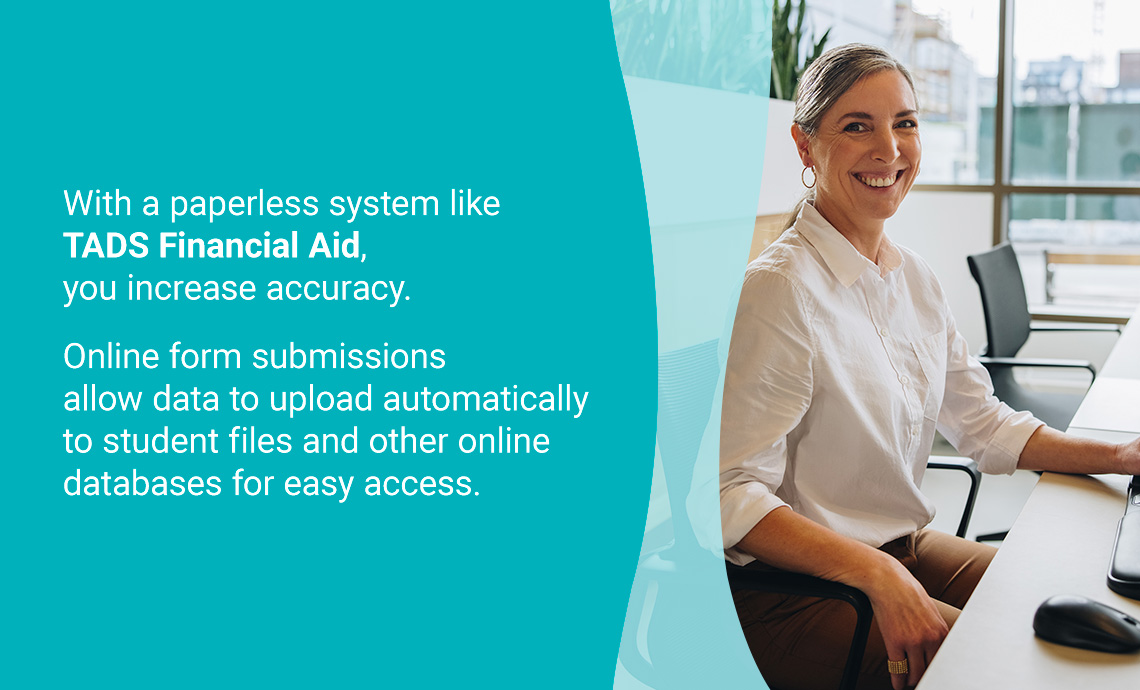
5. Reduced Costs
Paperless systems can also lower operational costs. Improved accuracy reduces costly errors with admissions or financial aid processes. By minimizing these errors, you boost efficiency across all departments and save vital funds.
With more room in your budget, your school can allocate more funds toward your teachers and classroom resources. You can offer more events, hire people to perform at your school, or transport your students to fun field trips. Or, save for bigger investments if your school needs repairs or new facilities.
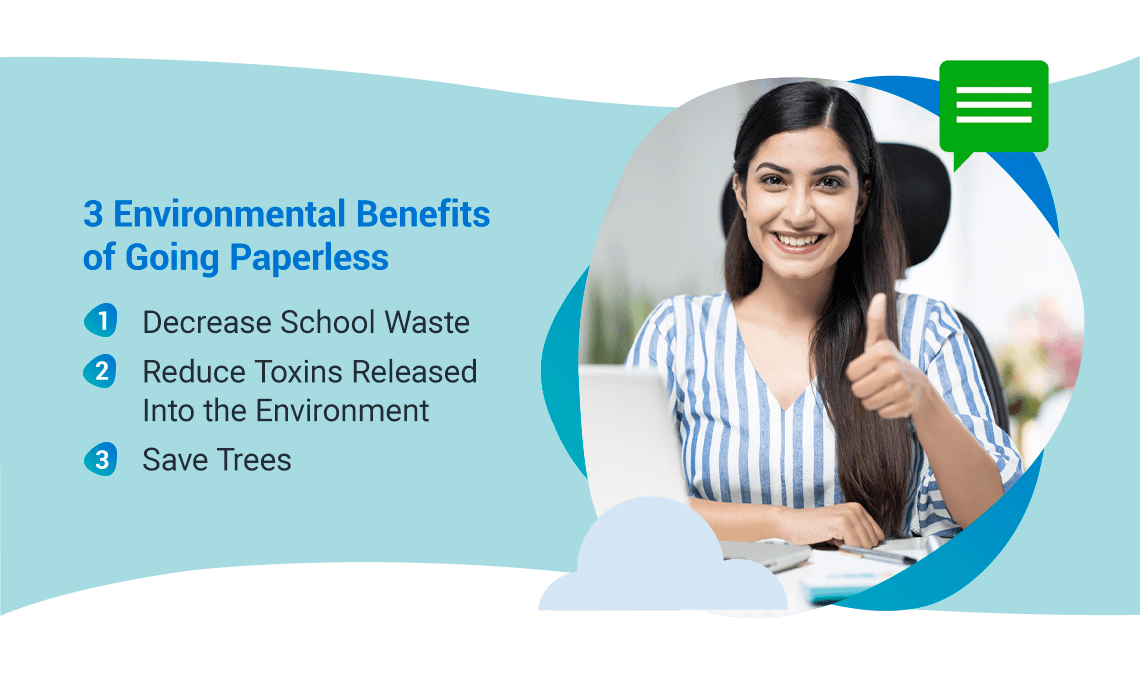
3 Environmental Benefits of Going Paperless
In addition to benefitting your school, reducing your paper use offers several sustainability and eco-friendly benefits. Paper-based waste accounts for the largest percentage of municipal waste production. By relying on paper for your school’s organizational processes, you add to the large volume of waste production.
Paperless systems, like TADS software suites, help you minimize your carbon footprint. You can implement greener initiatives for your entire school, starting with a comprehensive paperless solution.
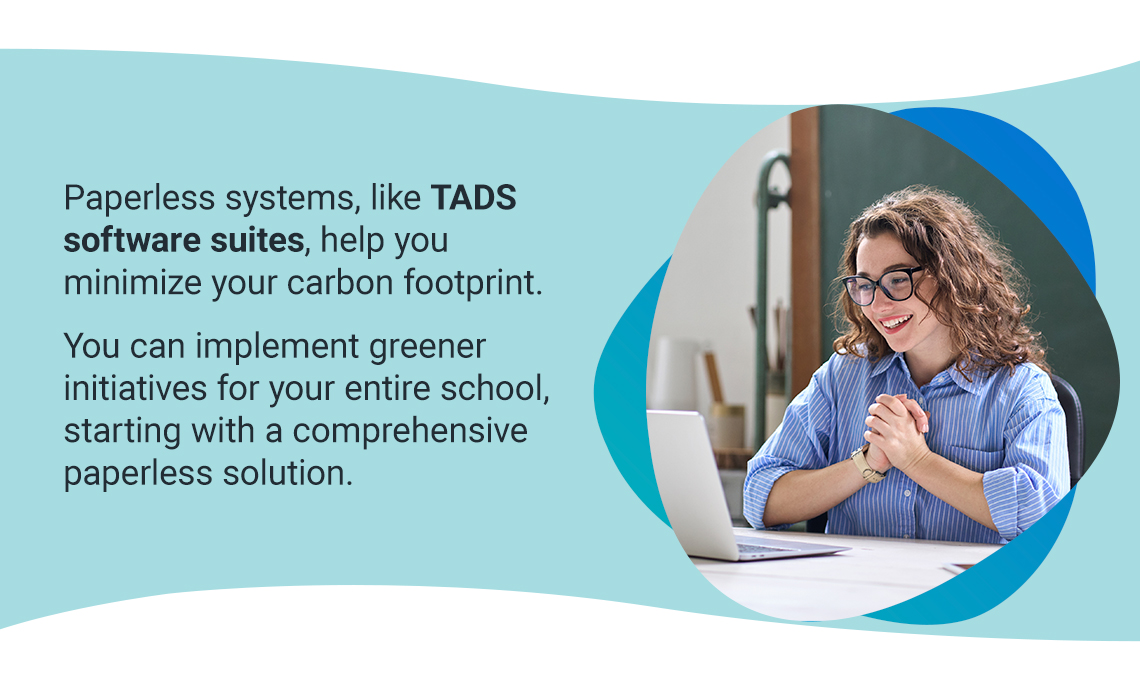
Here are three environmental benefits of going paperless:
1. It Decreases School Waste
Schools use large quantities of paper each day throughout the school year. While some paper is stored in administrative offices, other pieces of paper get discarded after use. Teachers across grades and disciplines use vast amounts of paper for classwork and worksheets, homework, tests, permission slips, progress reports, and report cards.
Paper products comprise a large portion of landfills, accounting for nearly 12% of all landfill waste. After students and families use the papers, they usually discard them, which increases your school’s waste. At the end of the year, your administrators might go through filing cabinets and discard their accumulated forms and paperwork, adding more to your carbon footprint.
Your school can reduce how much it contributes to waste collection and landfills by going paperless. This option reduces the amount of trash in landfills and creates more sustainable solutions to better support the planet.
2. It Reduces Toxins Released Into the Environment
Paper production creates toxic byproducts. Manufacturing paper can release carbon dioxide, sulfur, and nitrogen into the atmosphere and negatively impact local ecosystems. These substances in air particles can contribute to greenhouse gases, water pollution, and acid rain.
Paper in landfills can also harm the environment. Because paper comes from many organic materials, it can break down and decompose, making it more ideal for many industries than plastic. However, paper releases methane gas as it rots, which is more harmful to the environment than carbon dioxide.
Using less paper decreases product demand and manufacturing rates. You limit your school’s impact on the environment, creating a greener atmosphere.
3. It Saves Trees
Many organizations prefer paper products over plastic and other materials because trees are a renewable resource. However, people often consume and demand paper products quicker than trees can regrow. Tree growth rates vary by tree type and growth conditions. When consumers use so much paper, tree populations fail to meet the demand, resulting in deforestation and the destruction of ecosystems.
Trees play several essential roles for the planet. They use carbon dioxide and produce oxygen, creating a healthier environment for mammals that depend on oxygen to breathe. Trees can improve the air quality when other processes can put large amounts of carbon dioxide into the air and reduce the quality.
Additionally, trees play vital roles in many habitats and life cycles. Insects, birds, and animals depend on trees for food and shelter. Whether creatures eat bark and leaves or insects buried in the trunk, trees sustain life and support local food chains. The shade offered by trees protects local flora from the harsh sunlight and creates an environment where they can thrive.
When humans choose to preserve trees and use alternatives to paper like digital systems, ecosystems have a chance to thrive and support the world around us.
Additional Strategies for Going Paperless
Implementing the TADS paperless billing system and admissions management solution is a great way to reduce your school’s paper use and help the environment. You can also take additional measures to limit your environmental impact, including:
- Assigning printer and copier allotments: Excessive printing and copying can increase your school’s paper use and environmental impact. By giving each teacher and administrator a set amount of pages they can print each year, you can limit their use. They must determine what’s essential to print or copy for smarter resource use.
- Emphasizing online learning techniques: Recorded lectures and online worksheets allow students to complete work at home. You can encourage these methods to create a more sustainable learning environment and limit paper use.
- Digitizing communication efforts: Teachers and administrators often use notes, flyers, and paper slips to communicate various information with families. However, these efforts can increase your school’s waste production and be less effective. Emails, texts, online calendars, and other virtual communication methods store all conversations and data in one place so families always have access to information.
- Using online marketing techniques: Letters and flyers sent through the mail can be robust marketing materials, but they add to your paper waste. Families might be interested in your school but still discard physical promotional materials. Reduce waste by switching to digital marketing. Social media posts, email campaigns, and video content are great ways to engage with families without wasting paper resources. Additionally, families and students can return to content at any time, helping them keep track of essential information.
Go Paperless With TADS Solutions
TADS can help support your school’s goal to turn paperless and streamline several essential private K-12 processes. As a centralized system, all data is located in one place for easy access, increased visibility, and improved reliability. Your administrators can quickly assess candidates and make stronger decisions when they no longer have to navigate comprehensive filing systems to locate information.
Our comprehensive system offers several functions, from admissions and enrollment management to efficient tuition management. You can choose exactly what services you need, making the platform completely tailored to your needs. We’re experts in the education industry, creating software designed for schools like yours to support your daily operations.
Request a demo from TADS today to discover the benefits of paperless school processes.
